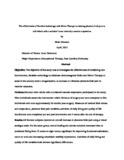The effectiveness of Farabloc technology with Mirror Therapy in reducing phantom limb pain in individuals with a unilateral lower extremity vascular amputation
Author
Houston, Helen
Abstract
Objective :the objective of this study was to investigate the effectiveness of combining two interventions, Farabloc technology to eliminate electromagnetic fields and Mirror Therapy to assist in the sensory cortex reorganization, to decrease or eliminate phantom limb pain in vascular amputees. Methods:fourteen older adults with a unilateral vascular amputation participated in the study. Nine individuals started the intervention within 48 hours of surgery and were compared to five individuals who were approximately 18 months post-surgery. Measures of residual limb edema and temperature, phantom limb pain variables, activities of daily living and quality of life interference were completed pre and post intervention and 4 weeks after the end of therapy. Results:all fourteen subjects reported an overall decrease in phantom limb pain using a visual analogue scale. For the acute group, wound healing and edema reduction decreased time to prosthetic fitting from 12 weeks to eight weeks, significant for improving functional ambulation, return to work and decreasing wheelchair mobility dependence. Activities of daily living and quality of life variables both showed significant differences. Conclusion:use of this combined treatment protocol shows promising results for not only acute amputee intervention, but also improved perception of pain and improved quality of life for amputees with chronic phantom limb pain. Implications for activities of daily living and quality of life are discussed
Date
2012
Citation:
APA:
Houston, Helen.
(January 2012).
The effectiveness of Farabloc technology with Mirror Therapy in reducing phantom limb pain in individuals with a unilateral lower extremity vascular amputation
(Master's Thesis, East Carolina University). Retrieved from the Scholarship.
(http://hdl.handle.net/10342/3894.)
MLA:
Houston, Helen.
The effectiveness of Farabloc technology with Mirror Therapy in reducing phantom limb pain in individuals with a unilateral lower extremity vascular amputation.
Master's Thesis. East Carolina University,
January 2012. The Scholarship.
http://hdl.handle.net/10342/3894.
June 29, 2024.
Chicago:
Houston, Helen,
“The effectiveness of Farabloc technology with Mirror Therapy in reducing phantom limb pain in individuals with a unilateral lower extremity vascular amputation”
(Master's Thesis., East Carolina University,
January 2012).
AMA:
Houston, Helen.
The effectiveness of Farabloc technology with Mirror Therapy in reducing phantom limb pain in individuals with a unilateral lower extremity vascular amputation
[Master's Thesis]. Greenville, NC: East Carolina University;
January 2012.
Collections
Publisher
East Carolina University

